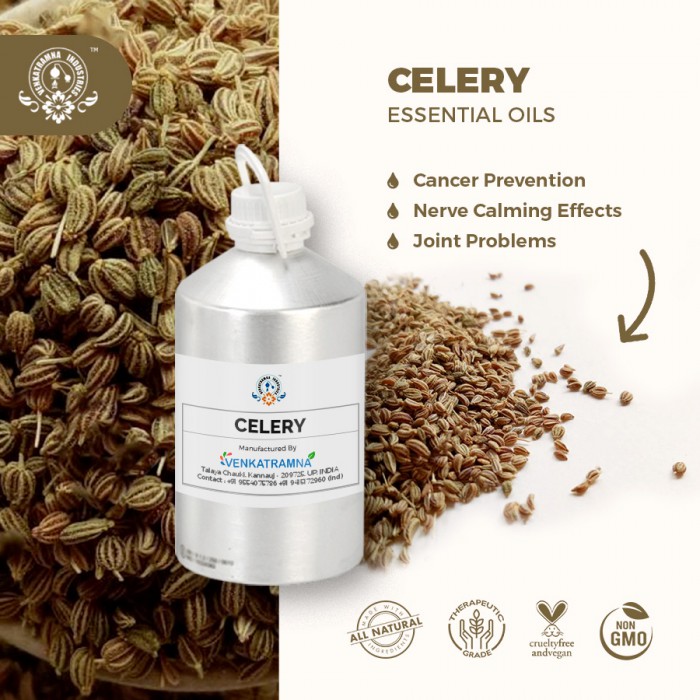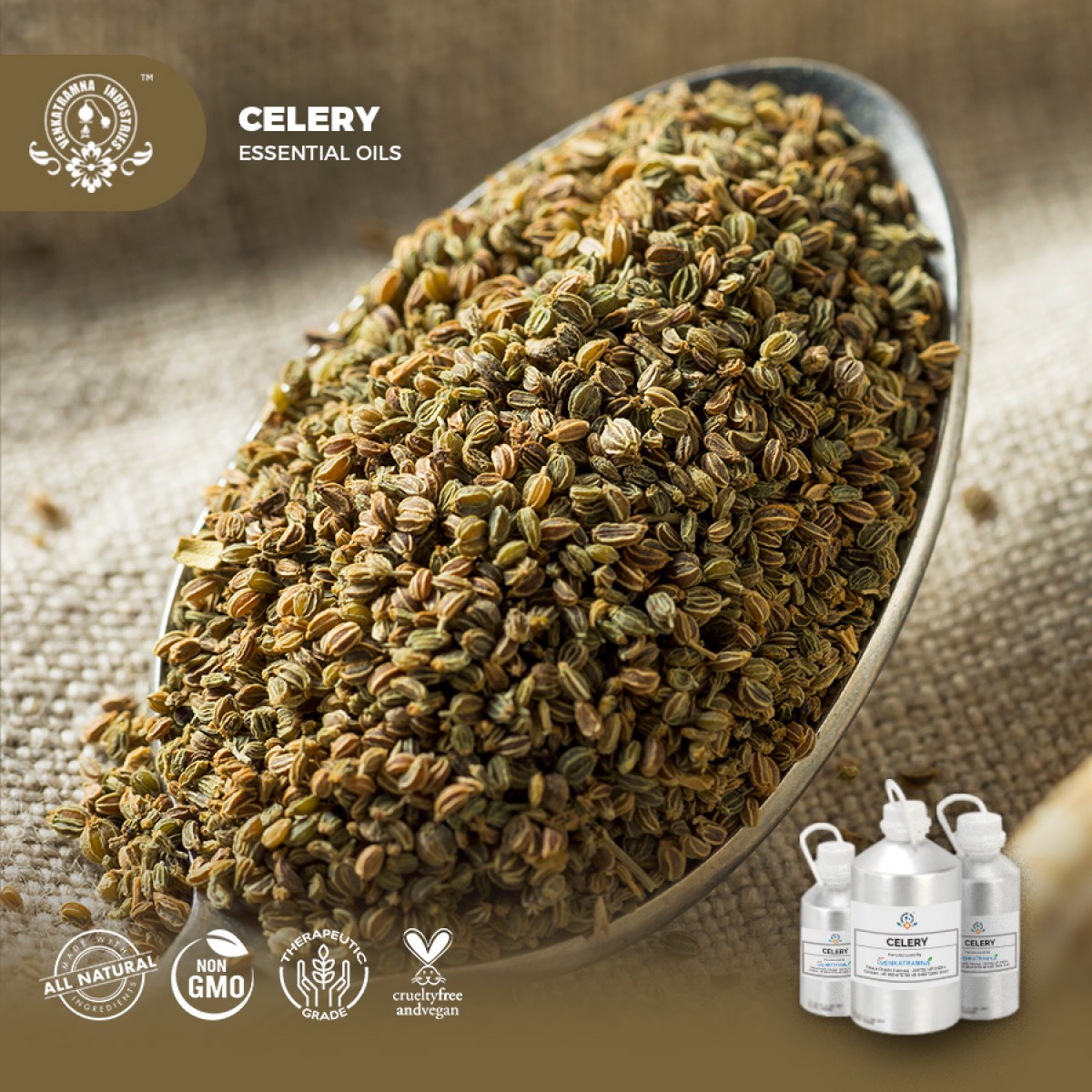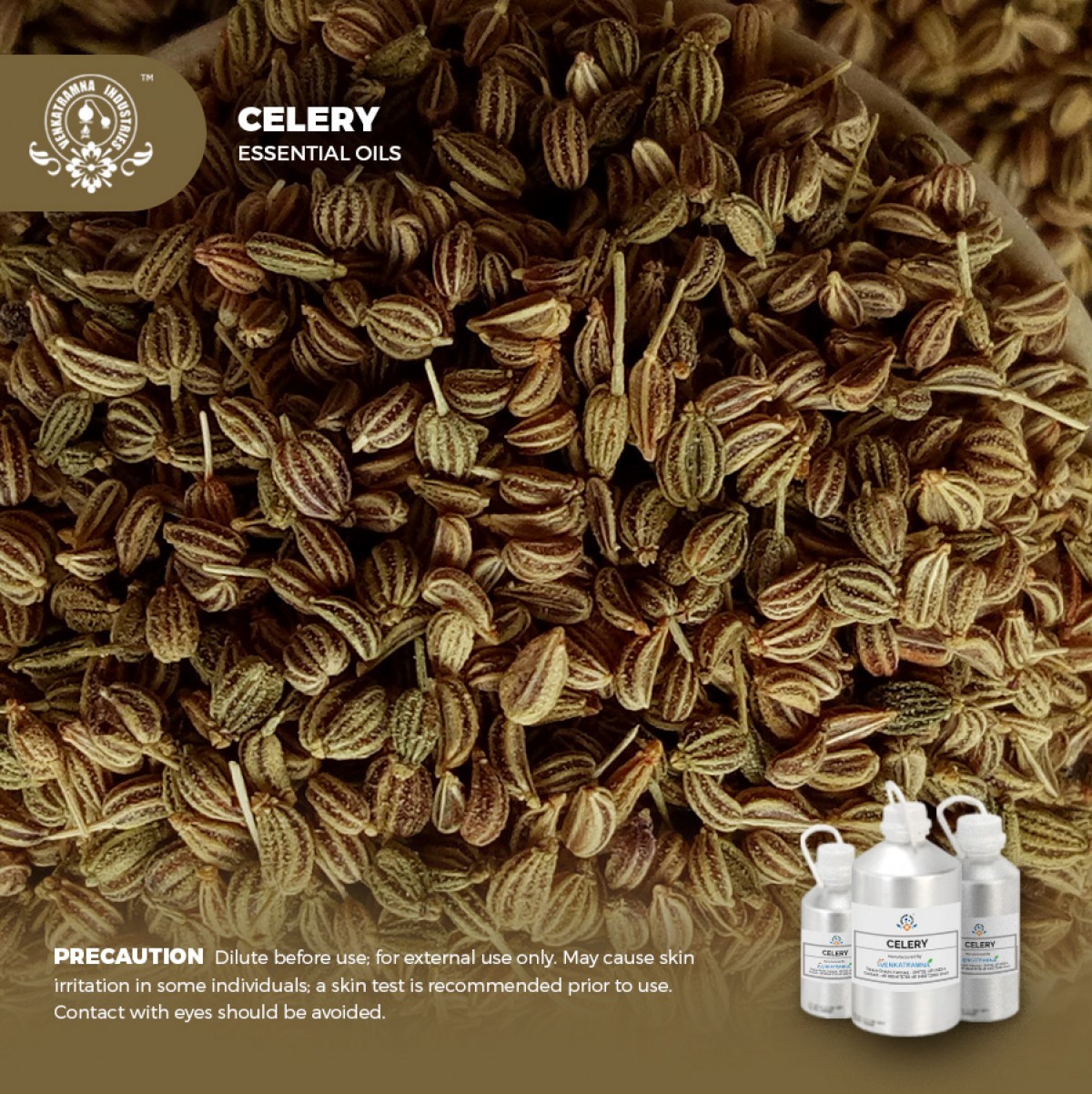Botanical Name: Apium graveolens Common name: Karafs, Ajmud, Celery P Read More
|
Botanical Name: |
Apium graveolens |
|
Common name: |
Karafs, Ajmud, Celery |
|
Plant family: |
Apiaceae |
|
Genus: |
Apium |
|
Appearance/Color: |
A thin,
yellowish brown liquid. |
|
Odor: |
A medium note with a medium aroma, Celery Seed Essential Oil has
a warm, fresh and spicy scent. |
|
Blends With: |
Clove Bud, Cinnamon Bark, Tea Tree, Lovage, Pine,
Lavender. |
|
Origin: |
India |
|
Source: |
Seeds |
|
Method of
Extraction: |
Steam Distillation |
Apium graveolens, the botanical name of Ajamoda. This is also
known as celery. It is annual or bionomical herbaceous plant. It is known to be
the native of Mediterranean regions like Asia, Africa and Europe. It grows up
to the height of 60 to 90 cm. the root system is of tap root system. Wild
plants grow with fragrance and pinnately divided leaves. In other form,
biennial form, plants have a basal rosette of leaves in primary years, later
near summers, it florates in off white flowers in umbels. Umbels are with
property of inflorescence. The flowers of the plants are so small with five
petals of ovule shape within floured tips. The carpals of the flower are in
semi trade sub pentagonal and filiform. The primary ridges of the carpals are
very much distinct. The fruit of the plant is schizocarp (a dry fruit when
ripe, splits into single seeded parts). These fruits are aromatic, 1 to 2 mm in
diameter, with two mericarps, sub orbicular and ellipsoid. The color of the
flowers are greyish brown. There is cross pollination found in this plant.
Ajamoda is ancestor of two different kinds of crops.
Celery was first cultivated as a food plant in Europe, mainly
in Italy and France. From here, the plant spreads to Sweden, Algeria, Egypt,
and Ethiopia and then to Kingdom of Saudi Arabia (KSA). Central Region (Najd)
is said to be the main geographical region of this plant in the KSA.
A. graveolens (Karafs) is being used as anthelmintic, antispasmodic, carminative, diuretic, laxative, sedative stimulants in the Arab traditional medicine.
DISCLAIMER
The complete range of conditions
or methods of use are beyond our control therefore we do not assume any
responsibility and expressly disclaim any liability for any use of this
product. Information contained herein is believed to be true and accurate however,
all statements or suggestions are made without warranty, expressed or implied,
regarding accuracy of the information, the hazards connected with the use of
the material or the results to be obtained from the use thereof. Compliance
with all applicable federal, state, and local laws and local regulations
remains the responsibility of the user.
The FDA has not evaluated the
statements on this website. No claims are made by Venkatramna Industries as to
the medicinal value of any products from vriaroma.com or by us. The information
presented here is for educating our customers about the traditional uses of
essential oils and is not intended to diagnose, treat, cure, or prevent any
disease. You are responsible for understanding the safe application of these products.
If you have any questions, please call or email us for further information.
As per NAHA guidelines, New Directions Aromatics (NDA) does not recommend the ingestion of essential oils. It is imperative to consult a medical practitioner before using Essential Oils for therapeutic purposes. Pregnant and nursing women and those taking prescription drugs are especially advised not to use this product without the medical advice of a physician. The oil should always be stored in an area that is inaccessible to children, especially those under the age of 7.
A. graveolens is a biennial plant locally known as “Karafs”,
belonging to family Apiaceae. Various parts of A.
graveolens are used in hepatic and spleen disorders, brain
disorders, body pain, and sleep disturbances. Celery has been used in the
traditional system of medicine to treat spasm and stomach problems and as
diuretic, laxative, and sedative. It is used as heart tonic to lower the blood
pressure in African traditional medicine in Trinidad and Tobago. There is also
a report to the use of celery in joint problems. The celery seed is well known
as libido stimulant in the traditional system of medicine due to its protective
role against the sodium valproate in testes and amplification of the sperm
profile. It also increases the secretion of breast milk.
Celery also stimulates semen production and relieves
offensive breath. Al-Rajhi said that one should avoid eating celery if he/she
fears that he/she might suffer a scorpion sting. A.
graveolens is a big source phenolic compounds, which provides
a good source of antioxidants. The antioxidant activity of Karafs leaf was
investigated (by scavenging of the 1,1-diphenyl 2-picrylhydrazyl [DPPH] radical
activity) and found to be a strong natural antioxidant by inhibiting oxidant
process. It may be attributed to its antioxidant constituents including
L-tryptophan and derivatives of methoxy-phenyl chromenone. The seed oil of the
celery has a strong larvicidal, adulticidal, and repellent activity against
the Aedes aegypti larva, the
vector of dengue hemorrhage fever. In another study, the mosquito repellent
activity of celery oil (with 5% vanillin) was found better repellent activity
than a number of commercially used repellent.
Celery is valued not only for its
nutritional properties but also for the distinctive aroma which it owes to the
presence of phthalide-rich essential oil. Thus, Apium graveolens is
widely used as a spice and flavoring ingredient in food products. The current
trend toward the use of natural preservatives triggered research on
antibacterial, antifungal, and antioxidant properties of volatile oils,
including celery.
COMMON USAGE
·
Lowers High Blood Pressure
·
Cancer Prevention
·
Provides Calcium
·
Pain Reliever
·
Mosquito Repellant
·
Nerve Calming Effects
·
Prevents Gout and Arthritis
·
Help in energy production and antioxidant
defense
·
Joint Problems
·
Reduces Muscle Spasms
·
Anti-Bacterial Properties
·
Can help individuals sleep
·
Blood Pressure
·
Celery seeds can assist in red blood cell
formation
·
Lowers Cholesterol
·
Kidney Stone
Ingredients:
|
S.No |
Key Constituents |
Strength (%) |
|
1 |
(þ)-Limonene |
68.0–75.0 |
|
2 |
b-Selinene |
2.0–12.5 |
|
3 |
a-Selinene |
2.0–12.1 |
|
4 |
Butylidene phthalide |
2.3–8.0 |
|
5 |
Sedanolide |
2.3–3.8 |
|
6 |
3-Butyl phthalide |
2.1–3.0 |
|
7 |
Ligustilide |
0–2.4 |
|
8 |
Sedanenolide |
2.2–2.3 |
|
9 |
Pentylbenzene |
1.7–2.0 |
|
10 |
Linalool |
0–1.5 |
|
11 |
b-Myrcene |
1.0–1.2 |
|
12 |
a-Pinene |
0.1–1.0 |
Safety Summary
·
Hazards: Skin sensitization if oxidized.
·
Cautions: Old or oxidized oils should be
avoided.
Organ-specific effects
·
Adverse skin reactions: Undiluted celery
seed oil was not irritating either to rabbits or to mice; tested at 4% on 25
volunteers it was neither irritating nor sensitizing. It is non-phototoxic.
Autoxidation products of (þ)- limonene can cause skin sensitization.
·
Reproductive toxicity The low
developmental toxicity of (þ)- limonene in rabbits and mice suggests that
celery seed oil is not hazardous in pregnancy.
Systemic effects
·
Acute toxicity Celery seed oil acute oral
LD50 in rats >5 g/kg; acute dermal LD50 in rabbits>5 g/kg.
·
Antioxidant/pro-oxidant activity Celery
seed oil showed moderate antioxidant activity as a DPPH radical scavenger and
high activity in the aldehyde/carboxylic acid assay.
·
Carcinogenic/anticarcinogenic potential
Celery seed oil dose-dependently inhibited aflatoxin B1-induced adducts in calf
thymus DNA, in the presence of rat liver microsomes. Celery seed oil
significantly induced glutathione S-transferase activity in mouse tissues.
(þ)-Limonene displays anticarcinogenic activity . Sedanolide and 3-butyl
phthalide reduced the incidence of forestomach cancer in mice.
·
Toxic to aquatic organisms, may cause long-term
adverse effects environment. Avoid any pollution of ground, surface or
underground water.
·
Persistence & degradability
Biodegradability: no degradability data is available; the substance is
considered as not degrading quickly.
·
Bioaccumulation Potential No additional data
available.
·
Mobility in soil No additional data available.
·
Results of PBT and vPvB Assessment No additional
data available.





 MSDS-Celery.pdf
MSDS-Celery.pdf




